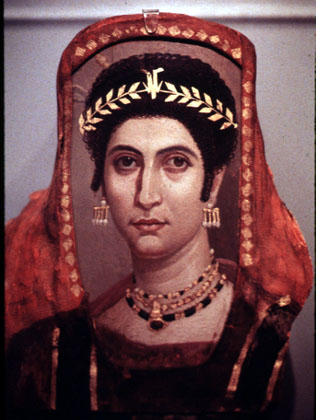 |
|
|
|
| Class
Prep |
|
|
|
Disciplining Dress: Telling Women What to Wear

- Today's primary reading comes from the pen of one of early
Christianity's most misogynist authors, Tertullian. Tertullian
was a leading Christian apologist in North Africa, and later (ironically?) a convert to the female-led Montanists. But in his earlier period, as he
defended Christianity in an often hostile Roman Empire,
he found it equally important to encourage
Christian men and women to behave as "true Christians"
and not like the Gentiles (non-Christians/non-Jews) around
them. He did not want Christian women to look like the Roman
woman from Fayum, Egypt, to the right, with her well-coiffed
hair, gold-embroidered garment and veil, and elaborate jewelry. Our student excavator today, if we have one, will also give us a sense of Roman clothing conventions for women.
-
- Begin by reading the excerpt from Elisabeth Schüssler Fiorenza. She discusses the ways that various cultures dictate norms of women's dress and behavior (many of her insights could equally be applied to men, though she doesn't). What "four strategies" does she identify that cultures use to socialize western women into submission? She also adds four Christian theological arguments through which the teaching of "love" has been used to legitimate domination (and even abuse) of women. Then read the piece by Kelly Olson, which establishes some of the conventions of elite women's dress in the Gentile (Roman) world in the period 200 BCE–200 CE (Tertullian's dates are 160–220 CE). There is a link toward the bottom of the page to an archive
of images of Roman women's clothing. You might want to skim
it to see the styles Olson is describing and Tertullian is berating.
-
- Tertullian is one of the most gifted speakers/writers
in early Christianity. In his treatise, "On the Dress of
Women," he gets right to his thesis. As you read, identify
his thesis. Then identify which of Schüssler Fiorenza's four secular strategies and four theological arguments are exemplified in Tertullian's argument.
-
-
- Assigned Readings
-
- Primary: Tertullian, "On the Apparel of Women" (Camino)
-
- Secondary:
Schüssler Fiorenza, excerpt from Sharing Her Word: Feminist Biblical Interpretation in Context (pp. 143-52) and Olsen, "Matrona and Whore: Clothing and Definition in Roman Antiquity," pp. 186-204 in Prostitutes and Courtesans in the Ancient World (Camino); online class prep
-
- Slides for Lecture
-
-
- Today's Author
-
| |
 |
Elisabeth Schüssler Fiorenza is Krister Stendahl Professor of Divinity at the Harvard Divinity School |
| |
 |
Kelly Olson is an Assistant Professor in the Department of Classical Studies and on the Faculty of Law at the University of Western Ontario; she also chairs the Graduate Program in Classical Studies |
-
-
- Dig Site 5: Clothing and Dress in Rome (Italy)
-
-
- Further Reading
-
- Calef, Susan A. "Rhetorical Strategies in Tertullian’s 'De Cultu Feminarum.'" Ph.D. Dissertation, University of Notre Dame, 1997.
-
- Church, F. Forrester. "Sex and Salvation
in Tertullian." Harvard Theological Review 68 (1975) 83-101.
-
- Gleason, Maud W. "The Semiotics of Gender: Physiognomy and Self-Fashioning in the Second Century C.E." In Before Sexuality: The Construction of Erotic Experience in the Ancient Greek World (ed. David M. Halperin, John J. Winkler, Froma I. Zeitlin; Princeton, New Jersey: Princeton University Press, 1990) 389-415.
-
- Hoffman, Daniel. The Status of Women and Gnosticism
in Irenaeus and Tertullian. Lewiston, New
York: Edwin Mellen, 1995.
-
- Miles, Margaret R. "Patriarchy as Political
Theology: The Establishment of North African Christianity" In
Civil Religion and Political Theology (ed. Leroy
S. Rauner; Notre Dame, Indiana: University of Notre Dame
Press, 1986) 169-186.
-
- Milnor, Kristina Lynn. "Suis Omnia Tuta Locis: Women, Place, and Public Life in the Age of Augustus." Ph.D. Dissertation, University of Michigan, 1998.
-
- Richlin, Amy. "Pliny’s Brassiere." In Roman Sexualities (ed. Judith P. Hallett and Marilyn B. Skinner; Princeton, New Jersey: Princeton University Press, 1997) 197-220.
-
- Sebesta, Judith Lynn. "Women’s Costume and Feminine Civic Morality in Augustan Rome." In Gender and the Body in the Ancient Mediterranean (ed. Maria Wyke; Gender and History; Malden, Massachusetts: Blackwell, 1998) 105-117.
-
- Shumka, Leslie Joan. "Designing Women: Studies in the Representation of Femininity in Roman Society." Ph.D. Dissertation, University of Victoria, Canada, 2001.
-
- Torjesen, Karen J. "Tertullian's 'Political Ecclesiology' and Women's
Leadership." In Studia patristica (Louvain: Peeters, 1989) 277-82.
-
- Wyke, Maria. "Women in the Mirror: The Rhetoric of Adornment in the Roman World." In Women in Ancient Societies: "An Illusion of the Night" (ed. Léonie J. Archer, Susan Fischler and Maria Wyke; New York: Routledge, 1994) 134-51.
-
-
-
- Links
-
-
-
- Sources
-
- Photograph: Barbara F. McManus, "The Flavian Coiffure,"
an image detail from "Roman Clothing: Women,"
Scintilla/VRoma, online, http://www.vroma.org/~bmcmanus/clothing2.html.
|
|
|
|
|
|
|
